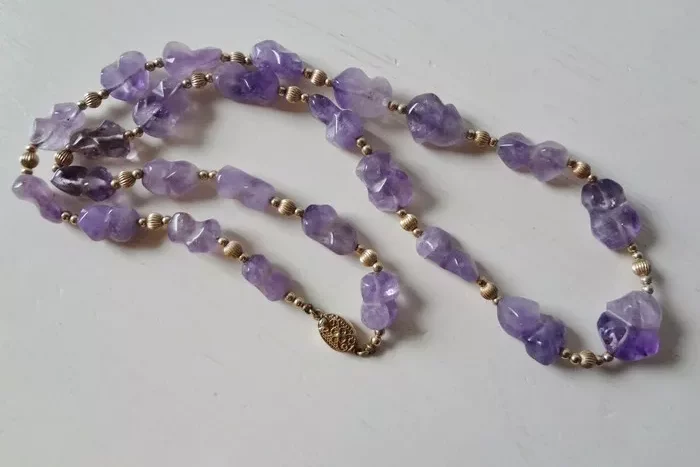Amethyst, a mesmerizing gemstone known for its deep purple hues, has held a unique fascination in Western cultures for centuries. Its name, derived from the Greek “amethystos,” meaning “not drunken,” reflects an ancient legend that wearing this stone would prevent intoxication. This enchanting gemstone has been the subject of numerous myths, legends, and jewelry designs, each contributing to its rich cultural tapestry. This article aims to provide a detailed introduction to amethyst, exploring its characteristics, historical significance, and unique role in Western societies.
The Characteristics of Amethyst
Amethyst belongs to the quartz family, a group of minerals characterized by their silicon dioxide composition and crystalline structure. What sets amethyst apart from other quartz varieties is its vibrant purple color, ranging from delicate lavender to deep, royal purple. This coloration is due to trace amounts of iron and other impurities within the mineral’s crystalline structure.
Optical Properties:
Color: Varies from light lavender to deep purple.
Clarity: Can be transparent, translucent, or opaque.
Refractive Index: Ranges between 1.544 and 1.553, contributing to its brilliance.
Hardness: Rated 7 on the Mohs scale, making it suitable for most jewelry settings.
Occurrence:
Amethyst is found worldwide, with notable deposits in Brazil, Uruguay, Sri Lanka, and the United States. The gemstone is often mined in pegmatite deposits, which are large, coarse-grained igneous rocks.
Historical Significance in Western Cultures
Ancient Beliefs and Legends:
In ancient Greek mythology, Amethyst was a nymph who, tired of the persistent advances of Dionysus, the god of wine, sought refuge with Artemis, the goddess of the hunt and the moon. Artemis, sympathetic to Amethyst’s plight, transformed her into a stone to protect her from Dionysus’s desires. In frustration, Dionysus poured wine over the nymph, turning the stone purple—the color of wine. Hence, the legend that amethyst prevents drunkenness was born.
Medieval and Renaissance Periods:
During the medieval and Renaissance periods, amethyst was highly valued for its supposed healing properties and mystical powers. It was believed to calm the mind, bring clarity, and protect against addiction. Monks and clergymen often wore amethyst rings and pendants as symbols of piety and wisdom.
Royal and Noble Favor:
Throughout history, amethyst has been favored by royalty and the nobility. In Western Europe, during the Middle Ages, amethyst was a popular gemstone for royal regalia and religious artifacts. Kings and queens adorned themselves with amethyst jewelry, believing it enhanced their power and wisdom.
Modern Jewelry and Fashion
Design Trends:
In modern Western jewelry design, amethyst remains a timeless gemstone. Its versatility allows it to be incorporated into a variety of styles, from classic to contemporary. Amethyst can be set in gold, silver, or platinum, and paired with diamonds, sapphires, and other gemstones to create striking pieces.
Popular Jewelry Types:
Rings: Amethyst engagement rings and cocktail rings are gaining popularity due to their unique color and affordability.
Pendants: Amethyst pendants are often used in necklaces, adding a touch of elegance and mystery to any outfit.
Earrings: Drop earrings and studs featuring amethyst can complement both casual and formal attire.
Bracelets: Amethyst beads are a staple in bracelet designs, offering a beautiful array of colors and textures.
Fashion Statements:
Amethyst’s deep purple hues make it a versatile gemstone for fashion. It can be paired with various colors, from neutral tones to bold hues, making it a great choice for those who want to make a statement with their jewelry.
Metaphysical Beliefs and Healing Properties
Calming Energy:
In modern Western culture, amethyst is still revered for its calming and soothing energy. Many believe it can help alleviate stress, anxiety, and promote inner peace.
Healing Powers:
Some people attribute healing properties to amethyst, believing it can help with physical ailments such as headaches, insomnia, and digestive issues. While these claims have not been scientifically proven, the gemstone’s popularity in alternative healing practices continues to grow.
Protection and Spirituality:
Amethyst is also considered a protective stone, believed to guard against negative energy and spiritual pollution. Many individuals wear amethyst jewelry as a talisman for protection and spiritual growth.
Care and Maintenance
Cleaning:
To maintain amethyst’s brilliance and color, it is essential to clean it regularly. Gentle soap and water or a jewelry cleaning solution specifically designed for gemstones can be used. Avoid harsh chemicals and abrasive cleaners, which can scratch or damage the stone’s surface.
Storage:
Store amethyst jewelry in a fabric-lined jewelry box or pouch to prevent scratching and protect it from exposure to extreme temperatures or humidity. Keep amethyst away from other gemstones that could cause abrasions.
Handling:
When handling amethyst, avoid sudden temperature changes, as this can cause cracks or fractures in the gemstone. Be cautious when wearing amethyst jewelry during activities that could expose it to physical trauma or chemicals.
Conclusion
Amethyst, with its rich history, mystical legends, and captivating beauty, continues to enchant Western cultures. Its versatility in jewelry design and its supposed healing and protective properties make it a popular choice for those seeking both fashion and functionality. Whether worn as a symbol of power, wisdom, or protection, amethyst remains a timeless gemstone that speaks to the hearts and minds of people worldwide.
Related topic:


